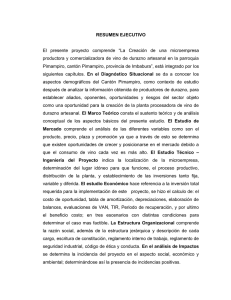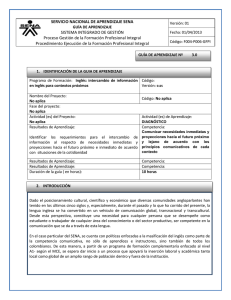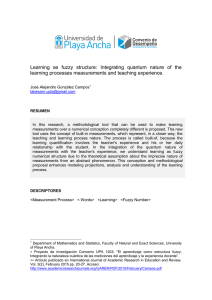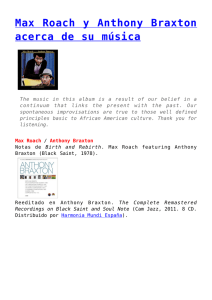descargable_guia_de_aprendizaje_2_b1_2 (1)
Anuncio
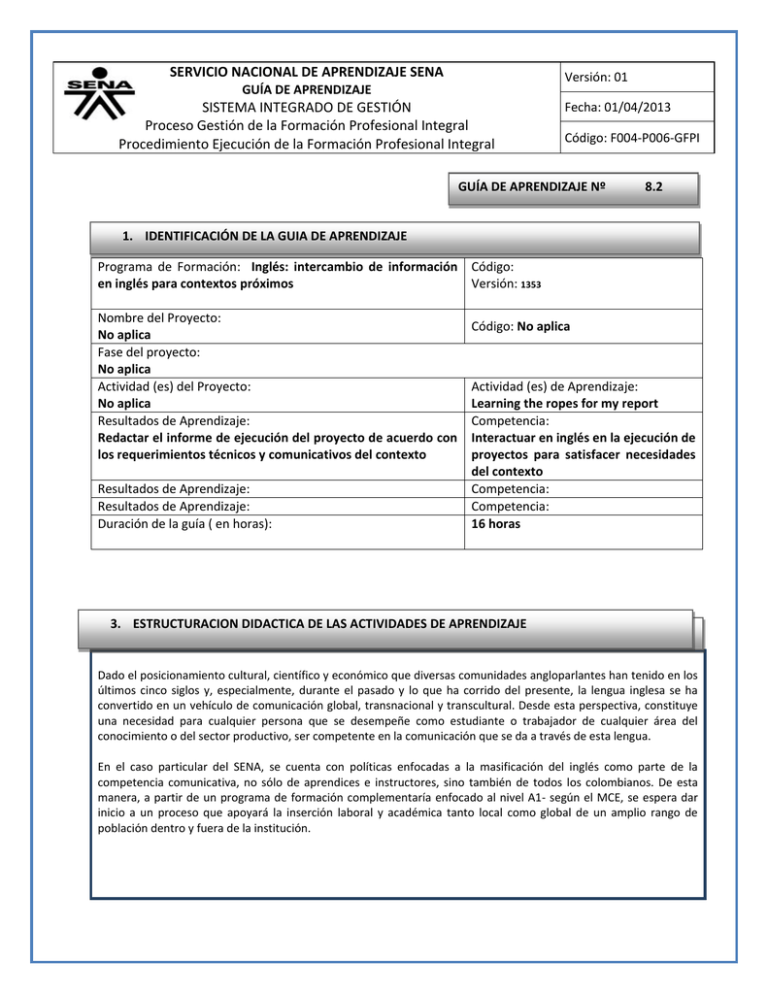
SERVICIO NACIONAL DE APRENDIZAJE SENA Versión: 01 GUÍA DE APRENDIZAJE SISTEMA INTEGRADO DE GESTIÓN Proceso Gestión de la Formación Profesional Integral Procedimiento Ejecución de la Formación Profesional Integral Fecha: 01/04/2013 Código: F004-P006-GFPI GUÍA DE APRENDIZAJE Nº 8.2 1. IDENTIFICACIÓN DE LA GUIA DE APRENDIZAJE Programa de Formación: Inglés: intercambio de información Código: en inglés para contextos próximos Versión: 1353 Nombre del Proyecto: No aplica Fase del proyecto: No aplica Actividad (es) del Proyecto: No aplica Resultados de Aprendizaje: Redactar el informe de ejecución del proyecto de acuerdo con los requerimientos técnicos y comunicativos del contexto Resultados de Aprendizaje: Resultados de Aprendizaje: Duración de la guía ( en horas): Código: No aplica Actividad (es) de Aprendizaje: Learning the ropes for my report Competencia: Interactuar en inglés en la ejecución de proyectos para satisfacer necesidades del contexto Competencia: Competencia: 16 horas 3. ESTRUCTURACION DIDACTICA DE LAS ACTIVIDADES DE APRENDIZAJE 2. INTRODUCCIÓN Dado el posicionamiento cultural, científico y económico que diversas comunidades angloparlantes han tenido en los últimos cinco siglos y, especialmente, durante el pasado y lo que ha corrido del presente, la lengua inglesa se ha convertido en un vehículo de comunicación global, transnacional y transcultural. Desde esta perspectiva, constituye una necesidad para cualquier persona que se desempeñe como estudiante o trabajador de cualquier área del conocimiento o del sector productivo, ser competente en la comunicación que se da a través de esta lengua. En el caso particular del SENA, se cuenta con políticas enfocadas a la masificación del inglés como parte de la competencia comunicativa, no sólo de aprendices e instructores, sino también de todos los colombianos. De esta manera, a partir de un programa de formación complementaría enfocado al nivel A1- según el MCE, se espera dar inicio a un proceso que apoyará la inserción laboral y académica tanto local como global de un amplio rango de población dentro y fuera de la institución. Guía de Aprendizaje 3.1 Actividades de Reflexión inicial Para esta actividad los aprendices escuchan una conversación en la que Anthony llama al profesor Brown para concretar una cita para mostrarle los avances de la planeación de su proyecto, y porque necesita algunos consejos para escribir su reporte. Esta actividad es evaluada a partir de unas preguntas de comprensión del audio como aparece a continuación: 1. Based on the previous video, answer the following questions. 1.1 What is the main purpose of Anthony’s call? a. To tell Professor Brown what he has been doing b. To ask Professor Brown about their next meeting c. To say hello d. To boast about his work 1.2 Why is Professor Brown surprised? a. Because Anthony is confused. b. Because Anthony called him. c. Because Anthony has improved his writing structures. d. Because Anthony has improved his speaking abilities. 1.3 What does Anthony say he can do now when he analyzes source-texts? a. Read long texts. b. Concentrate. c. Include everything he finds in his writings. d. Read and decide what to include and what to leave out. 1.4 Professor Brown talks about the HOCs and the LOCs. According to what he says, what are they used for when writing a text? a. to make a well-structured writing b. to base the research process on 1.5 What day of the week is it according to Anthony and Professor Brown’s conversation? a. Monday b. Saturday c. Thursday d. Friday 2. Listen to a part of Anthony and Professor Brown’s conversation, and then answer the questions that follow. 2.1 What does the expression put into words mean according to what he says? Anthony says: “I had no idea how to put into words what I was doing and the results I was obtaining.” a. to express with words one’s ideas or thoughts Página 2 de 6 Guía de Aprendizaje b. to define words or expressions 2.2 What does he mean when he says “I don’t like to boast”? Anthony says: “I don’t like to boast, but I have to say that I do better now that I base my writings on microstructure, macrostructure and superstructure.” a. He doesn’t like to write. b. He doesn’t like to talk about what he does in exaggerated terms. b. He doesn’t want the speaker to give opinion about what he does. 2.3 According to the context, what does the expression give a hand mean? Anthony says: “That has given me a good hand!” a. to say hello to someone b. to help someone c. to say good-bye to someone d. to hit someone 2.4 Which of the following words can replace the expression bear in mind? Professor Brown says: “You need to bear in mind that these aspects not only help you to structure your texts…” a. discuss b. remember c. forget d. take 2.5 According to this part of the conversation it is possible to conclude that: a. Professor Brown is busy doing exercise on Saturday. b. Anthony and Professor Brown are tired of meeting. c. Anthony is happy Professor Brown doesn’t want to meet on Saturday. d. Anthony can’t meet Professor Brown on Saturday. 3.2 Actividades de contextualización e identificación de conocimientos necesarios para el aprendizaje Las actividades que deben realizar los aprendices están divididas de la siguiente forma: Stage 1: Thorough knowledge to write! Correct the punctuation in a text. For the development of this evidence, you need to correct the punctuation in a classmate’s project abstract. The abstract is a brief summary of the subject of your project. Your tutor will decide which abstract you need to Página 3 de 6 Guía de Aprendizaje correct and improve. 1. Click on the How to check it button and take a look at the checklist to understand the assessment criteria for this task. 2. Once you have finished correcting and improving your classmate’s abstract, upload both versions, your partner’s and the one you corrected, to the evidences folder of the course. 3. Yes! It is as simple as it looks! Let’s review what you need to do! 1. Download the abstract your tutor wants you to correct. 2. Take a look at the punctuation correction checklist. 3. Correct or improve the punctuation in your partner’s text. 4. Upload the improved version to the evidences hand-in folder of the course. It is time for you to start working on the document! Stage 2: A noteworthy report! Write up a report using all the elements learnt with the materials. 1. It is time to write your report, friends! First of all, you need to think of the execution of your project. Bear in mind the suggestions and guidance your tutor has offered. 2. Then, consider including as many as the elements obtained from both of the learning materials of this stage. Consider, for example, proper phrase and sentence structures, punctuation, and argumentative organization and purpose. 3. Right after that, click on the How to check it? button, and take a look at the checklist to understand the assessment criteria for this task. 4. Once you have finished, upload your report to the evidences folder of the course. By doing this, you will be done with all the evidences of this second learning activity! Let’s review what you need to do! 1. Think of the execution of your project. 2. When writing, consider using as many elements learned from the materials as possible. 3. Take a look at the project execution report checklist. 4. Upload your report to the evidences folder of the course. Well, dear friends, I hope you have fun with this activity, and the result is a great quality product! I’ll see you soon! Página 4 de 6 Guía de Aprendizaje 3.3 Actividades de apropiación del conocimiento (Conceptualización y Teorización) Stage 1 – A doozy report Stage 2 – Above par report – My report will be above par 3.4 Actividades de transferencia del conocimiento NO APLICA 3.5 Actividades de evaluación Evidencias de Aprendizaje Evidencias de Conocimiento: Learning the ropes for my report Test (Evaluación de conocimiento) Evidencias de Producto: Corrige el abstract del proyecto de un compañero. El instructor escoge cuál debe ser corregido. Escribe el reporte de su proyecto usando elementos de los materiales de formación. Criterios de Evaluación Hace la planeación textual del informe de acuerdo con los recursos lingüísticos y cognitivos disponibles. Textualiza el informe de acuerdo con la planeación textual establecida. Implementa las acciones de mejora que se requieran a la luz de los procesos evaluativos. Técnicas e Instrumentos de Evaluación Examen de conocimiento Lista de chequeo para la corrección del texto Lista de chequeo para el reporte escrito del proyecto Presenta el informe de ejecución sobre la base de principios éticos relacionados con la honestidad y el respeto de los derechos de autor y la propiedad intelectual. 4. RECURSOS PARA EL APRENDIZAJE Actividad de aprendizaje 8.2 Ambiente social y productivo del aprendiz Programa english(dot)works B1 Level 2 Conocimientos adquiridos en B1 Level 1 5. GLOSARIO DE TERMINOS Página 5 de 6 Guía de Aprendizaje NO APLICA 6. BIBLIOGRAFÍA/ WEBGRAFÍA Listening Follow this link to improve your listening skills and get information about some principles for writing an essay: http://learnenglish.britishcouncil.org/en/writing-purpose/essays-listen Grammar Follow these links to review and practice punctuation: http://www.bristol.ac.uk/arts/exercises/grammar/grammar_tutorial/page_55.htm Follow this link to review Word order: http://www.english-4u.de/word_order_ex3.htm Vocabulary Follow these links to review and broaden your knowledge of conjunctions and connectors: http://www.fe.hku.hk/telec/pgram/5-gr/5342f/5342-022.htm http://englishmistakeswelcome.com/conjunctions.htm Pronunciation Follow these links to improve your pronunciation of the vowel sound /l/ and other principles: http://www.englishteachermelanie.com/pronunciation-how-to-pronounce-l-and-r-video/ 7. CONTROL DEL DOCUMENTO (ELABORADA POR) ANDRÉS CAMILO RAMÍREZ SANTANA Asesor didáctico de la línea de producción de la Regional Distrito Capital Página 6 de 6
